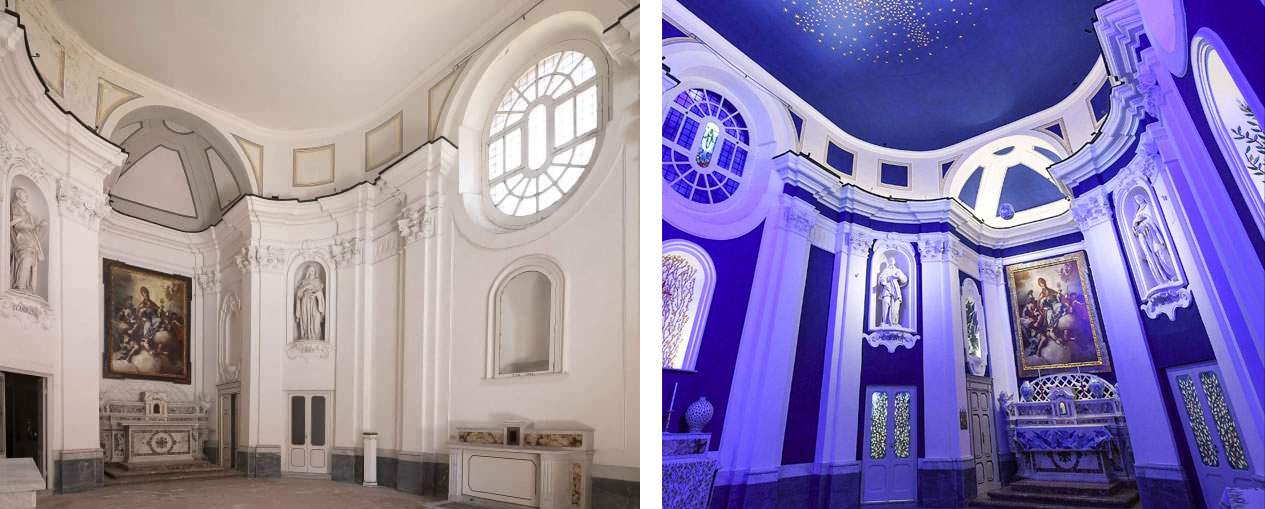Archistar Santiago Calatrava ’s work on the church of San Gennaro in the Real Bosco di Capdimonte, which had been closed for decades and was reopened the day before yesterday with new decorations signed by the Spanish architect, was not particularly welcomed by the public or several insiders. Calatrava illuminated the entire interior in blue to pay homage to the “light of Naples” thanks to the installation of stained glass windows made by a master glassmaker from Vietri sul Mare, and ultramarine blue is also the color with which the walls and ceiling were repainted, but that’s not all: the ceiling was decorated with 800 porcelain stars, a material also used to produce vases and candlesticks resting on the altars, which are in turn covered with silk vestments from San Leucio. Again, in the niches here is a cross sprouting among olive branches and, on the opposite side, another cross made with red flowers making its way among yellow flowers, all made of porcelain.
The church of San Gennaro, located inside the Bosco di Capodimonte, was built in 1745, designed by Ferdinando Sanfelice, architect of the Neapolitan court, at the behest of Charles of Bourbon, who was very devoted to the patron saint of Naples. The church remained open for worship until 1970, the year of the death of the last parish priest, Domenico La Gamba, after which, after being restored following damage produced by the 1980 earthquake, it was used from time to time as an exhibition space (and only occasionally reopened for worship). Calatrava’s intervention (which is not a restoration, as Minister Dario Franceschini mistakenly declared in an official note, but is simply a redecoration, of course reversible) has, however, been the subject of irony and sneers from the public, who have commented on photos of the “new” San Gennaro on the web, including on the Capodimonte National Museum’s social channels.
And comparisons were naturally wasted, with users having fun coming up with the most disparate similarities: a gas station bathroom, a McDonald’s toilet, an aquarium, a Dubai dentist’s waiting room, a Shanghai hotel shopping center, the Billionaire (or generic disco), a Perugina kiss, a shopping mall’s luxury boutique, a fish market, a nativity scene, an arcade, a solarium. For others, the intervention resembles the Toledo station of the Neapolitan subway. But there has also been no shortage of criticism from art historians and architects who have pointed the finger at the invasiveness of Calatrava’s intervention and his disregard for the church’s original appearance, deeming the redecoration too excessive.
Also participating in the controversy on social media was director Sylvain Bellenger, who responded in an irritated tone to the comments of a young Roman art historian, Flavio Garreffa, who was guilty of saying that “the originality of the place should be respected” without transforming the interior of the church into a kind of multimedia hall (“respecting and handing down art and history to posterity is also this,” Garreffa later added). Bellenger, addressing Garreffa directly, first rebuked him, saying stymiedly that “a little knowledge of the place and of the artist Calatrava seems to me necessary before launching polemics on social media.” Then, misrepresenting the young Roman professional’s comment, the Capodimonte director let it be known that “there is no multimedia installation” in the church and that the blue effect “is due to the replacement of the Plexiglas windows with cathedral glass.” And again, “Calatrava has not done a restoration” (but Garreffa had not said that Calatrava’s is a restoration), “but he has proposed a reversible decoration using the resources of Campania’s craftsmanship.” Finally, Bellenger even went so far as to compare Calatrava’s intervention to Henri Matisse ’s decorations in the Chapelle du Saint-Marie du Rosaire in Vence, Provence (moreover, confusing Vence with Saint-Paul-de-Vence and perhaps forgetting that Matisse did not intervene on an eighteenth-century church, but designed the chapel ex novo, also taking care of the decorations).
 |
One of the harshest opinions came from Raffaella Forgione, an architect who in recent years has worked in Director General Nistri’s team as a member of the Technical Secretariat of the Great Pompeii Project, was a restoration expert at the UNESCO Site of the Archaeological Park of Pompeii (from 2015 to 2018), and currently a member of the Design Office of the Archaeological Park of the Colosseum (from May 2019: in the last year he has had the role of supporting the executive design of the Flavian Amphitheater, as well as being technical-administrative support for infrastructural interventions financed by the Campania region, as a design expert in territories subject to architectural, archaeological, and landscape constraints). For Forgione, this is a “boorish image,” a “restoration that is not a restoration” that “a recent graduate just out of university could have done. ”In such a structure,“ Forgione went on to explain, ”you can only do a restoration. It is a listed property and as the regulations (ah this unknown) prescribe in a listed property you restore. Revivals such as this one by Calatrava are not only inappropriate altogether, but even detrimental to the original subject matter, which has literally been twisted and obliterated. I fear that in the future it will not even be possible to recover the original materials of the decorated surfaces." And similar comments abound on the social walls of other cultural professionals. In short: although many liked it, from most comes a resounding rejection. Even without bothering Matisse.
Pictured: the church before and after the intervention
 |
| Irony, sneers and criticism for Calatrava's redecorated church. And Bellenger gets irritated |
Warning: the translation into English of the original Italian article was created using automatic tools. We undertake to review all articles, but we do not guarantee the total absence of inaccuracies in the translation due to the program. You can find the original by clicking on the ITA button. If you find any mistake,please contact us.